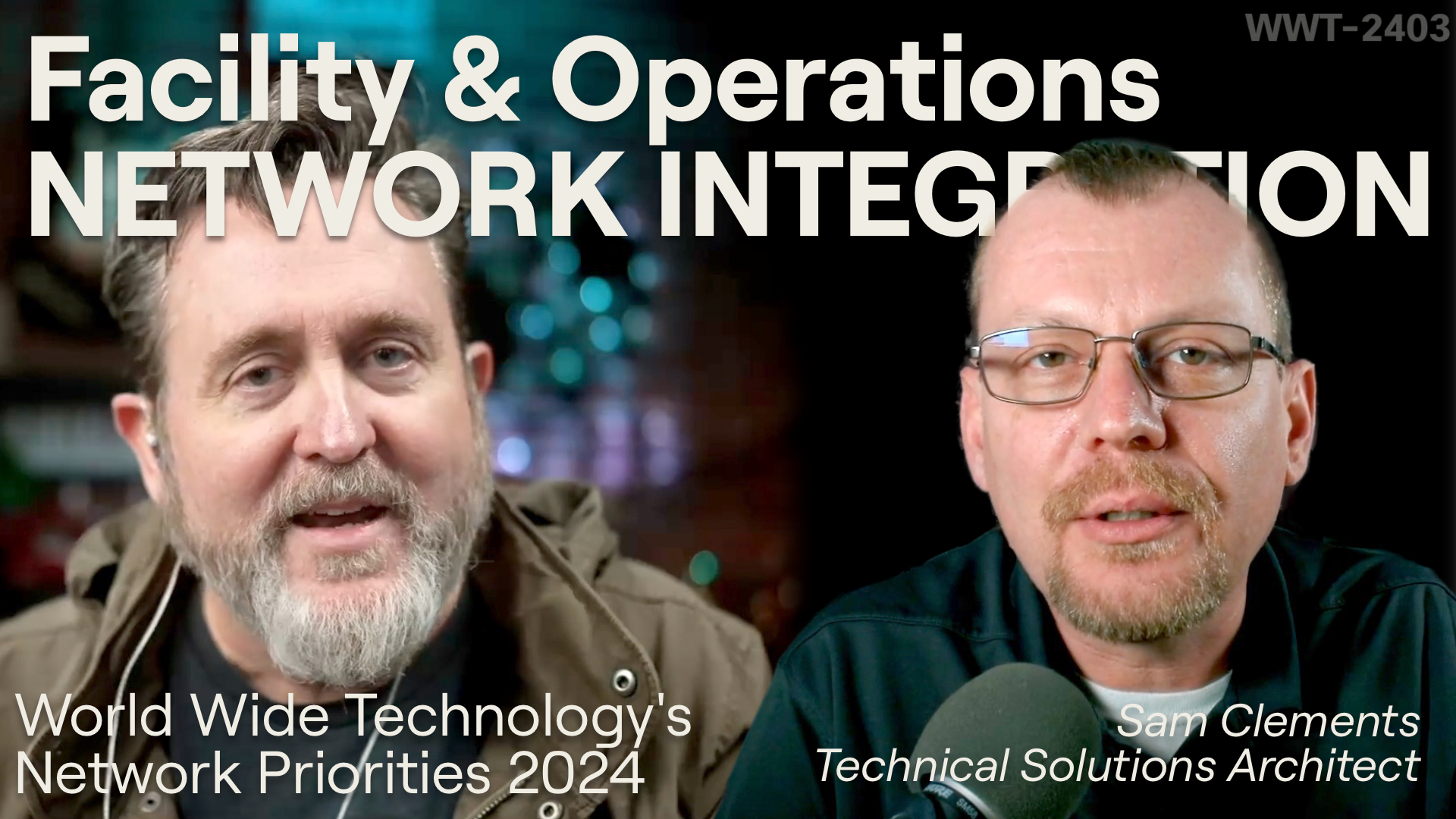The 2024 Networking Shift: AI-Driven Facility Integration
In 2023, our networking efforts centered on agility, security, and scalability, proving these are not mere buzzwords but essential elements that remain relevant in 2024. However, AI, once the ultimate buzzword, took center stage last year, prompting us to explore our response to its dominance.

When it came to networking in 2023, we largely kept our collective focus on three cornerstones: agility, security and scalability. Previously considered buzzwords by some, these are foundational items that don't go away in 2024. But the twist here is that the mother of all buzzwords, AI, dominated all of us last year...but now, it's time for us dig into how we should be responding.
PROMO:
It's a balancing act right?– injecting innovation without disrupting the flow. We're not just adding new gears; we're making sure they turn in harmony with the old ones.
Consider how each of the items blow is a step towards a more interconnected, efficient, and secure networking future:
- AI and machine learning are revolutionizing network performance, offering predictive analytics and automated responses to enhance efficiency and reliability.
- Secure Service Edge platforms are gaining traction, providing a more integrated approach to security and network services in the cloud era.
- The landscape of Original Equipment Manufacturers (OEM) in networking is transforming, marked by mergers, acquisitions, and new players challenging traditional market leaders.
- Network as a Service, Private Cellular Networks, and Quantum Key Distribution represent the forefront of networking innovation, each offering unique solutions to connectivity and security challenges.
WWT's Networking Priorities for 2024 research report will ultimately require multiple deep dive sessions, today's being only one small part.
- Priority 1: Optimize network performance with AI/ML
- Priority 2: Integrate networking into facility and operations management
- Priority 3: Adopt SSE for a secure, scalable and flexible network architecture
- Priority 4: Align OEM partnerships to business needs and goals
- Priority 5: Explore the capabilities of NaaS, PCN and QKD for innovation
Our charter for today's show is on Priority 2: Integrate networking into facility and operations.
The audience for this report ranges from CIO’s down through IT managers and hands-on practitioners. In my opinion, this priority almost seems assumptively phrased...as if IT needs to PUSH themselves into what is generally a distinct and very different department. But as we prepped for this episode, our guest expert, Sam Clements, and I started to feel like this could be more of a PULL action.
Facility management professionals, like everyone else, are not immune to the unique challenges posed by the rapid rise of GenAI and Large Language Models in direct communication.
This shift in thinking indicates that we should expect to engage with more integrated clients and consider our networks as platforms for operation, emphasizing how we conceptualize the architecture of our networks moving forward.
So what does this really mean?
!New Word Hypophora
A rhetorical term for a strategy in which a speaker or writer raises a question and then immediately answers it.
When a network is called "a platform," it means it's more than just for connecting—it plays a bigger role in enabling various activities and services. It's like a solid foundation for developers and users to build on. This setup allows for growth and network effects that you can't get with separate networks built for specific purposes. It supports a wide range of activities, creating a lively ecosystem with different business models and challenges.
This network-platform does a lot, driving the growth of a dynamic ecosystem. Here, new business models pop up, and unique challenges come up. It's a space where boundaries blur but specialization is still important. Departments have their roles, but they definitely overlap in this vibrant environment.
One crucial overlap begins with our method of wireless connection - a shared foundation for all activities on the network.
Let's consider the importance of 'data exhaust’…the leftover data from our digital activities. In the network-as-a-platform concept, this data is far from excessive effluvium to be discarded, it's a valuable resource waiting to be utilized. It’s our network endpoints, often ignored, that contain valuable opportunities for exploration and innovation.
Facility and Operations Management
In the realm of facilities and operations, prioritizing this area may seem unexpected at first glance. However, a closer look reveals why it's not just important but essential given the current industry challenges.
The post-Covid world has drastically changed how we utilize buildings and campus networks. The pandemic has shifted our relationship with physical spaces, leading to reduced foot traffic in office buildings and campuses. This shift raises a critical question: what is the future of these once bustling hubs?
Investments in these infrastructures are now uncertain, presenting both challenges and opportunities. Adapting to this change through enhanced efficiency is key.
Facilities management is crucial in this evolving landscape of hybrid work models. Traditional office buildings face scrutiny as the focus shifts from maintenance to reimagining their purpose. How can these spaces be transformed to meet the needs of a workforce no longer tied to a single location?
Facilities management must pivot towards strategies that optimize space, resources, and redefine the role of these buildings.
Creating flexible, tech-driven environments that cater to a diverse workforce is vital. This shift presents an unprecedented opportunity to reshape work environments in a post-Covid era.

Consider various use cases showcasing the rise of wireless connectivity and how they can build on each other:
- Location Services Enabled by Wireless Sensors: Wireless sensors in buildings offer precise location services, enhancing space utilization and safety by guiding occupants during emergencies and aiding first responders.
- Indoor Air Quality Monitoring with Wireless Sensors: In our post-Covid world, wireless sensors are crucial for monitoring indoor air quality, ensuring a healthier environment by tracking humidity, temperature, and contaminants.
- Building Systems Integration: Integration merges location services and air quality monitoring into a unified system, making buildings smarter and more responsive. This holistic approach enhances occupant experience and operational efficiency.
- Insights into Utilization Data Leveraging IoT: The Internet of Things (IoT) gathers data for analyzing space utilization, from peak occupancy times to underutilized areas. This data drives improvements in space planning, energy efficiency, and predictive maintenance.
These use cases illustrate how technology is reshaping buildings into dynamic entities that cater to occupants' needs, offering comfort, safety, and efficiency in innovative ways. This evolution reflects the future of facilities in a constantly changing world.

Avoid being strangled by the wireless thread.
The bright thread weaving through these use-cases is unmistakably 'wireless' technology. It's a thread that not only connects these diverse applications but also highlights their transformative potential. The very essence of modern building management seems to be pivoting on the axis of wireless innovation. This shift towards wireless systems is not just a trend; it's a fundamental change in how we interact with and manage our physical spaces.
This is precisely why we sought insights from wireless expert, Sam Clements.

Samuel Clements is a renowned wireless networking expert with top-tier certifications like Cisco's CCIE and the vendor neutral CWNE. He specializes in designing and implementing critical WLANs, used in sectors like healthcare. Clements also contributes to wireless networking education, reviewing certification guides, and plays a key role as a Mobility Technical Solutions Architect at World Wide Technology, focusing on innovative wireless solutions.
In an environment increasingly dominated by wireless sensors and IoT devices, understanding the nuances of these technologies becomes crucial. Sam's perspective sheds light on how these new integrations function, the complexities involved, and the potential they unlock.
As we've explored the transformative power of networking technologies and their integration into facility and operations management, it's clear that the future is brimming with potential. To truly grasp the depth and breadth of these innovations, we invite you to join us for "Using Networks as a Platform to Drive Facility and Operations Innovation." Here, you'll discover additional use cases that bring these concepts to life, from the seamless integration of IoT devices to the strategic deployment of Private Cellular Networks. We'll also tackle common counterarguments, such as concerns about security and the complexity of implementation, providing you with a well-rounded perspective on the state of networking today.
Don't miss this opportunity to deepen your understanding and see how these advancements can be leveraged to drive efficiency, security, and innovation within your organization. Tune in and be part of the conversation that's shaping the future of networking and operations.

